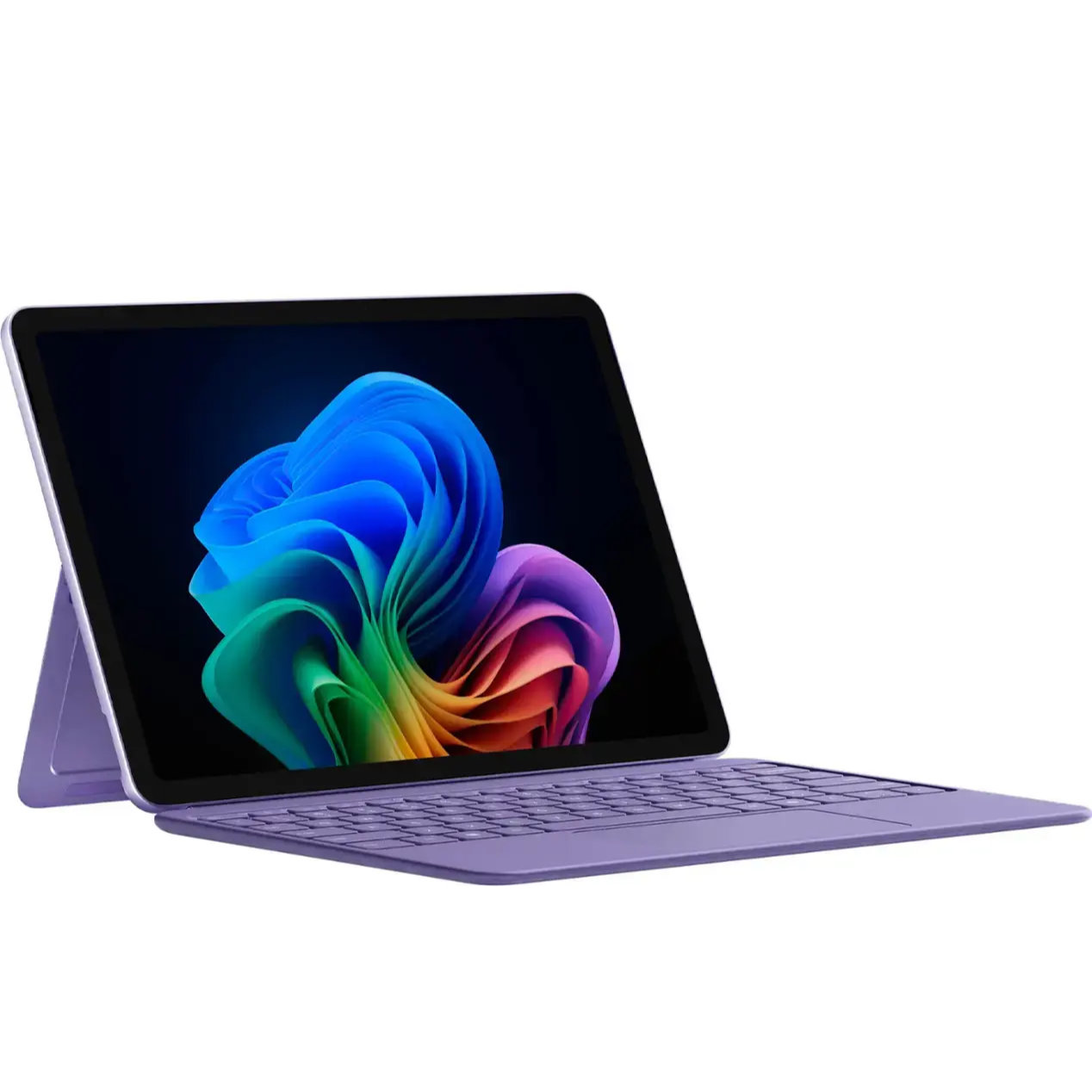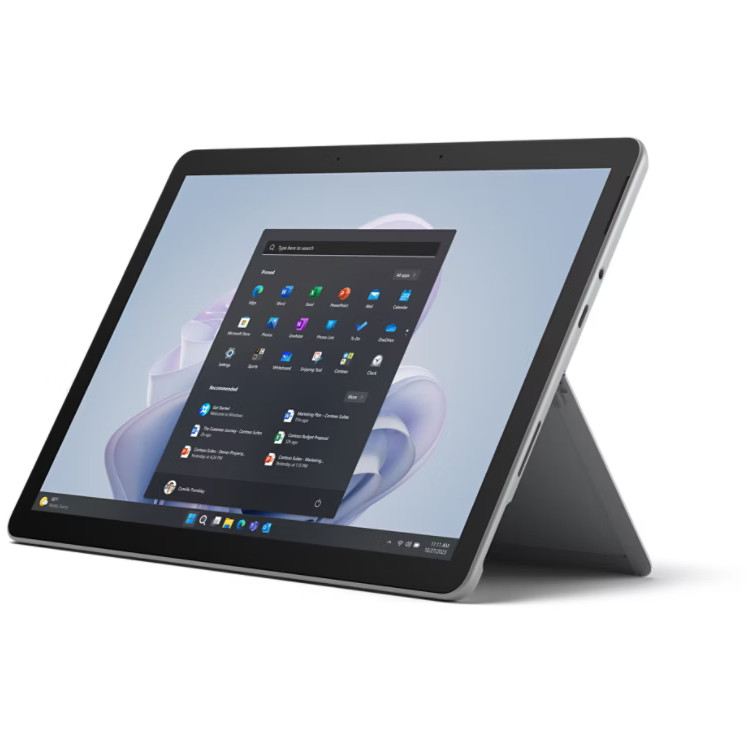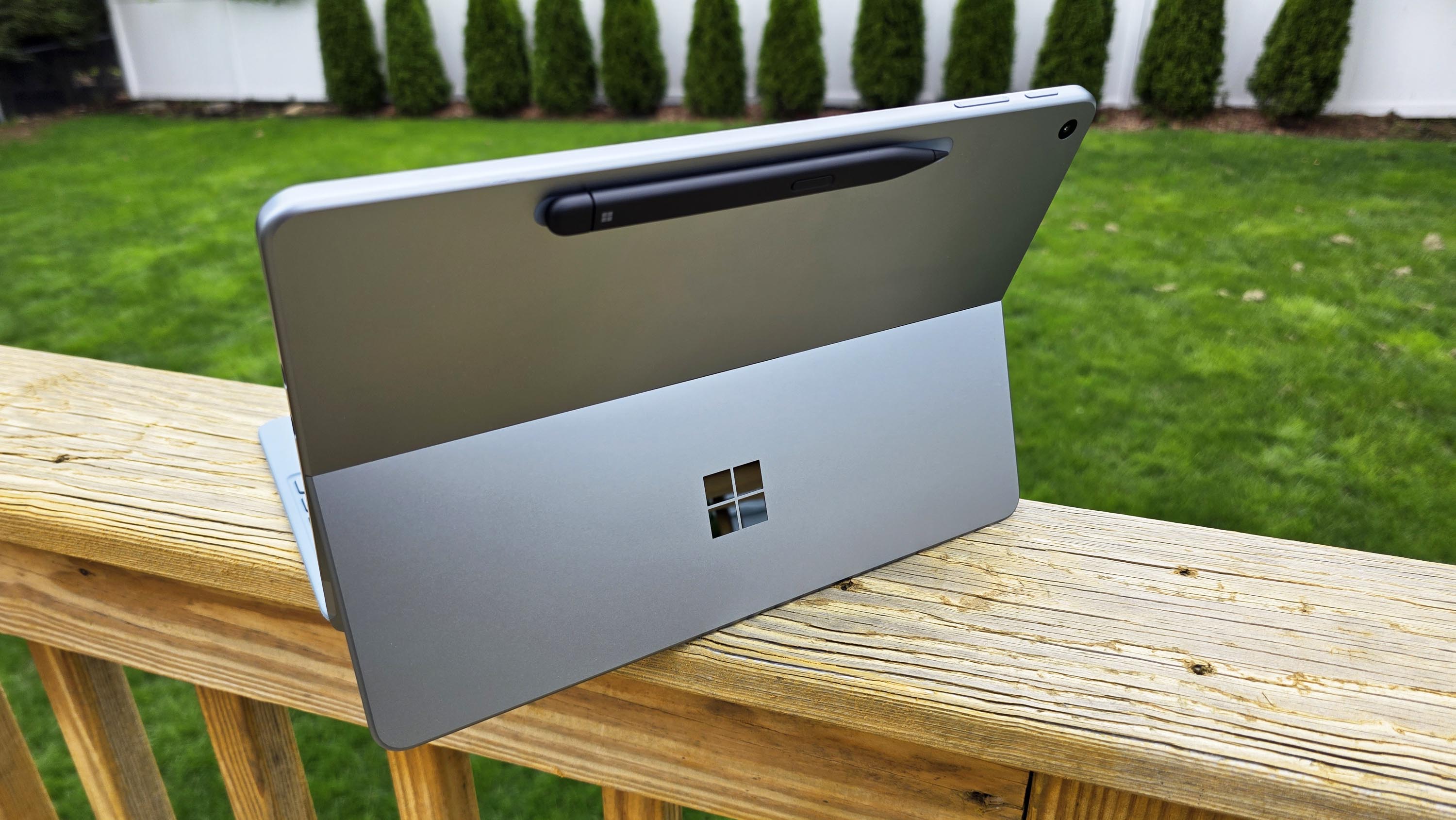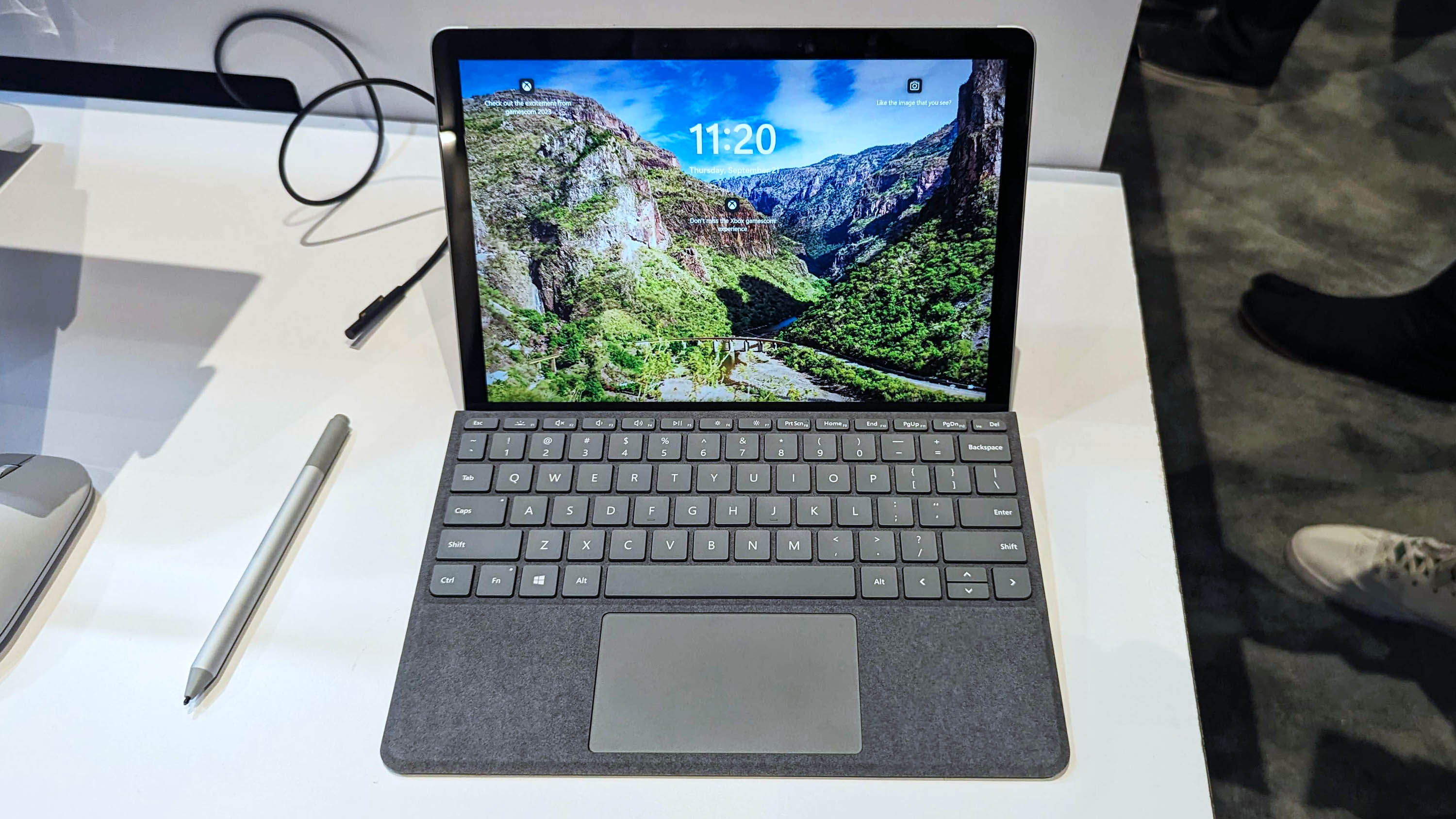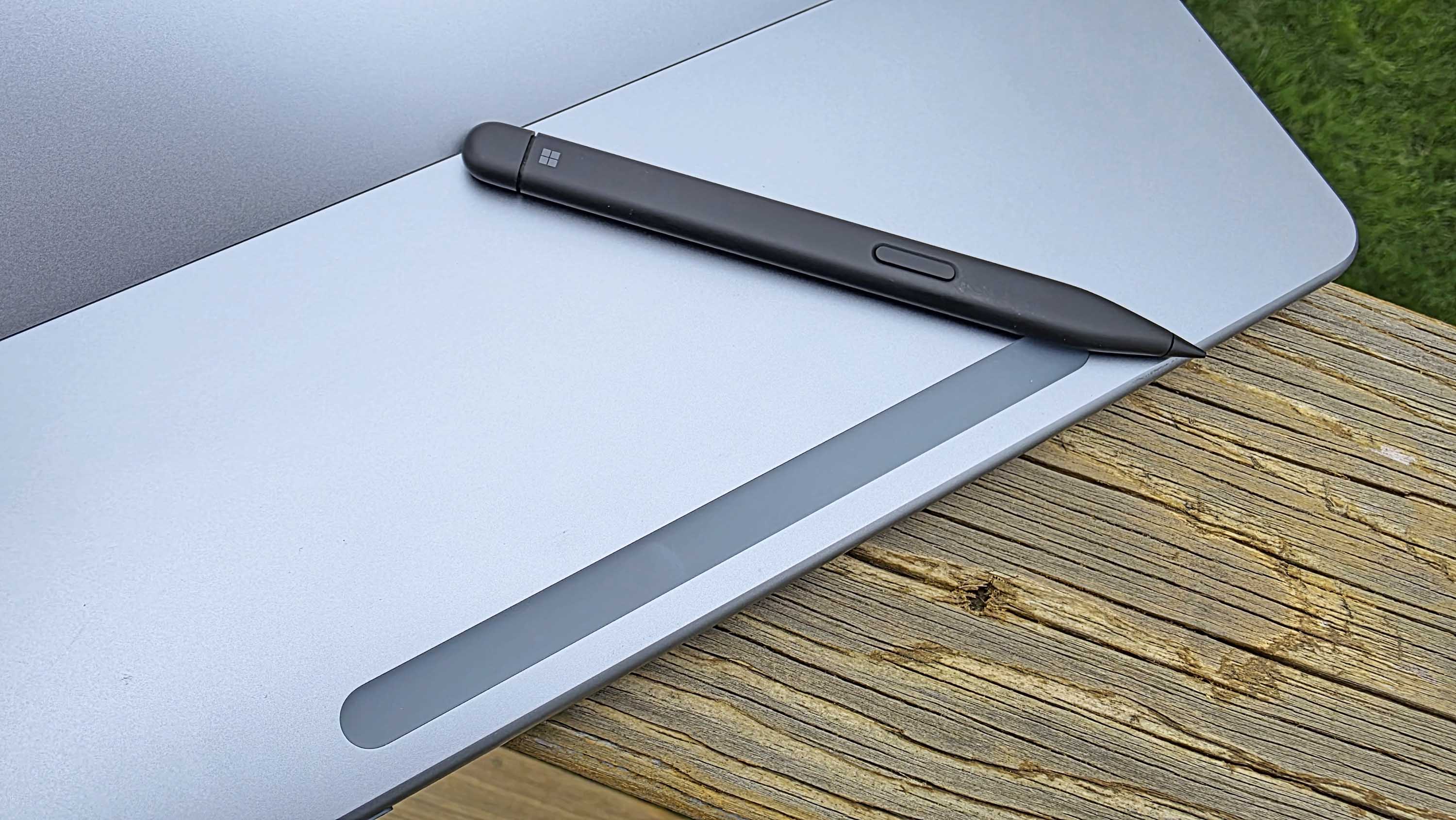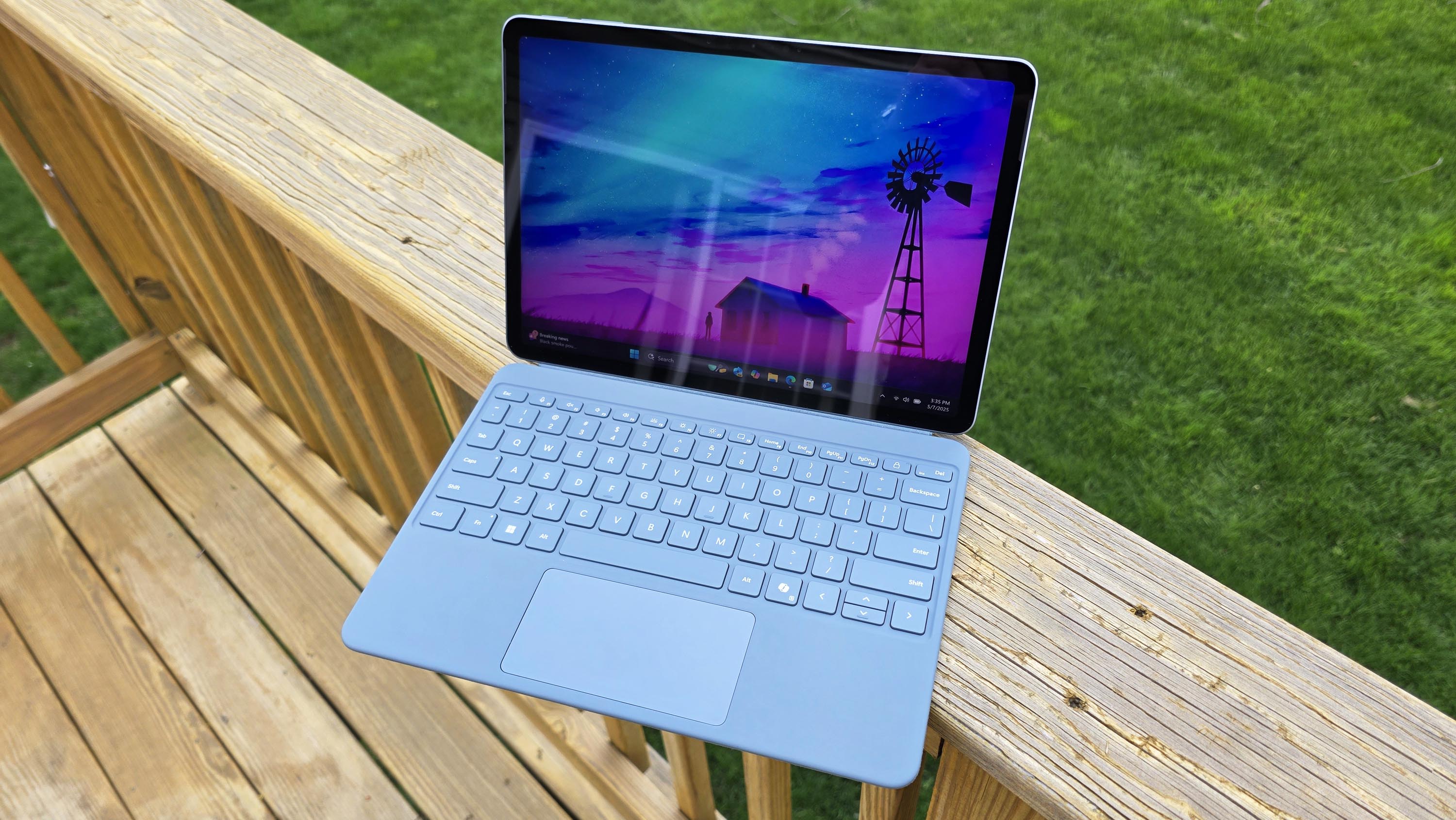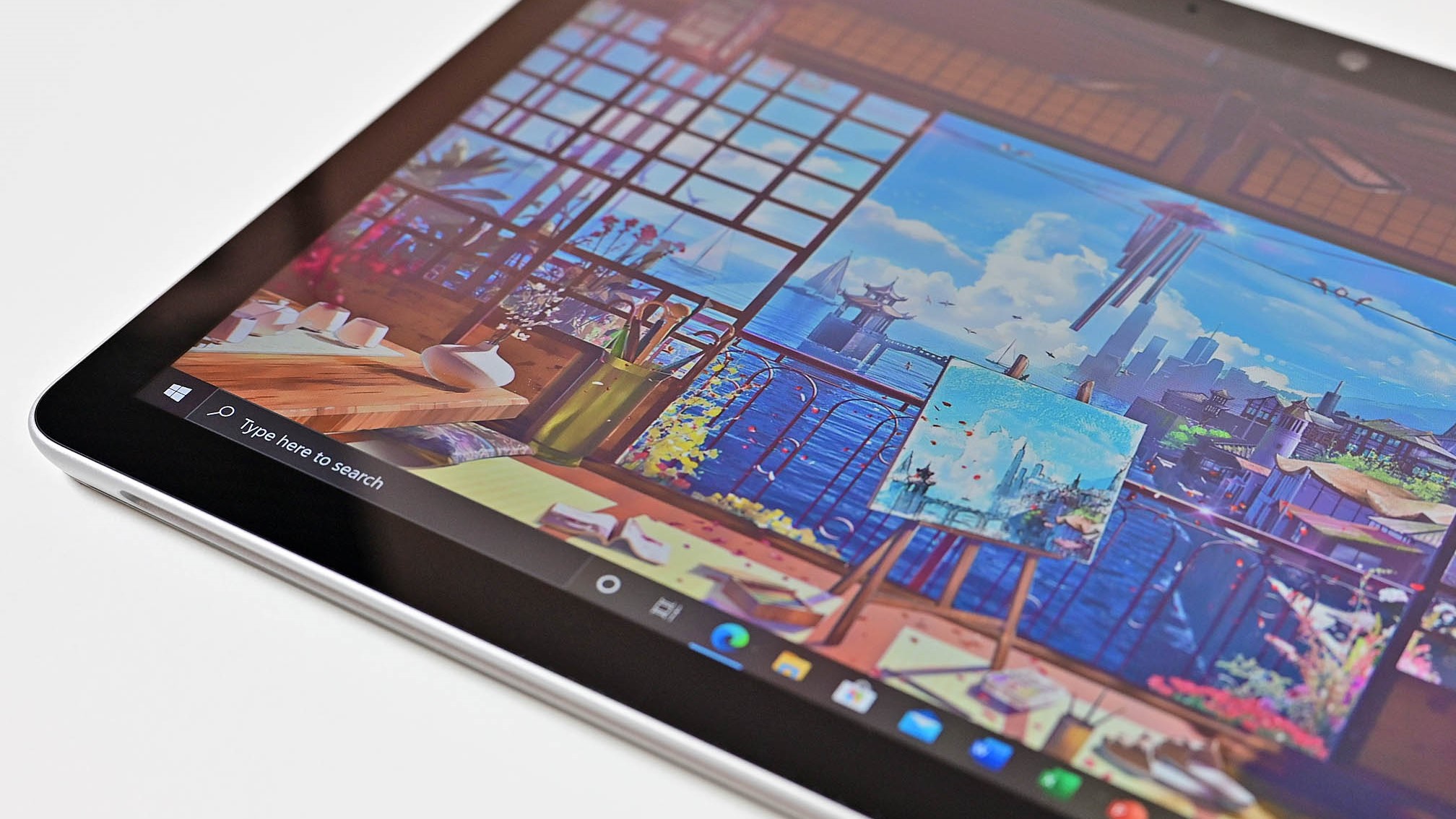The new Surface Pro 12-inch easily bests the Go 4 when it comes to performance and design. Considering the close price difference between the two devices, I can easily recommend the new Pro 12-inch over the Go 4 for the vast majority of users.
The Surface Go 4 has aged poorly due to its wimpy Intel N200 CPU. The Surface Pro 12-inch will run laps around the Go 4 without breaking a sweat. Unless you can find an incredible deal, I recommend against this 2-in-1 in 2025.
Pros
- Might find it for a bit less money
- microSD card reader and 3.5mm audio
- Solid camera and audio
- Runs standard Windows 11
Cons
- Intel N200 CPU isn’t useful for more than very light tasks
- Only 8GB of RAM
- UFS storage isn’t upgradeable
- Thicker display bezels
- No NPU for Copilot+
Microsoft unveiled its new Surface Pro 12-inch on May 6, 2025, and it’s expected to launch on May 20. The Surface Go 4, which launched in 2023, is another compact 2-in-1 that launched in 2023.
While Microsoft has stated that its new Pro 12-inch isn’t replacing the Surface Go line — it’s instead meant to add a more affordable option to its Copilot+ PC lineup — the newer 2-in-1 almost completely removes any enthusiasm and appeal for the Surface Go 4.
Short story? Buy the Surface Pro 12-inch. Long story? Read on for a detailed breakdown of the differences and similarities between the Surface Pro 12-inch and Surface Go 4.
Surface Pro 12-inch vs. Surface Go 4: Specifications
Before I dive into a more detailed breakdown, here’s a look at the raw specs that make up these 2-in-1 Surface devices.
| Header Cell – Column 0 |
Surface Pro 12-inch |
Surface Go 4 |
|---|---|---|
|
CPU |
Qualcomm Snapdragon X Plus X1P-42 (8 core) |
Intel N200 |
|
RAM |
16GB LPDDR5x |
8GB LPDDR5 |
|
GPU |
Qualcomm Adreno (integrated) |
Intel UHD (integrated) |
|
NPU |
Qualcomm Hexagon (45 TOPS) |
None |
|
Storage |
256GB, 512GB UFS (upgradeable) |
64GB, 128GB, 256GB UFS (soldered) |
|
Camera |
Front-facing 1080p + IR, rear-facing 10MP |
Front-facing 1080p + IR, rear-facing 8MP |
|
Speakers |
Dual 2W speakers, Dolby Atmos |
Dual 2W speakers, Dolby Atmos |
|
Display |
12 inches, 2196×1464 (2.1K), 220 PPI, LCD, 3:2 aspect ratio, 90Hz, touch, 400 nits |
10.5 inches, 1920×1280, 220 PPI, LCD, 3:2 aspect ratio, 60Hz, touch, 350 nits |
|
Ports |
Two USB-C 3.2 |
USB-C 3.1, microSD card reader, Surface Connect, 3.5mm audio |
|
Wireless |
Wi-Fi 7, Bluetooth 5.4 |
Wi-Fi 6, Bluetooth 5.1 |
|
Battery |
Up to 16 hours video playback |
Up to 12.5 hours of typical device usage |
|
Dimensions |
10.8 x 7.47 x 0.30 inches (274mm x 190mm x 7.8mm) |
9.65 x 6.9 x 0.33 inches (245mm x 175mm x 8.3mm) |
|
Weight |
1.5 pounds (686g) |
1.15 pounds (521g) |
|
Colors |
Platinum, Ocean, Violet |
Platinum |
|
Price |
From $799 |
From $689.99 |
Surface Pro 12-inch vs. Surface Go 4: Price and availability
Microsoft’s new Surface Pro 12-inch is now available for preorder at Microsoft and third-party retailers, with the official launch slated for May 20, 2025.
The Surface Pro 12-inch with a Snapdragon X Plus (X1P-42) System-on-Chip, 16GB of RAM, and 256GB of storage starts at $799.99 at Best Buy. It comes in a Platinum finish.
Doubling storage to 512GB, the price climbs to $899.99. Violet, Ocean, and Platinum colors are available for this pricier SKU.
The Surface Pro 12’s optional keyboard is sold separately for $149.99. It comes in Slate, Violet, and Ocean colors.
The optional Surface Slim Pen 2 adds another $129.99 to the total. You can save some money by bundling the Pro 12-inch Keyboard and the Slim Pen for $249.99 at Best Buy.
With keyboard, pen, and PC, you’re looking at spending about $1,050 for even the baseline package with 256GB of storage.
- Surface Pro 12-inch, Platinum, 16GB RAM, 256GB SSD: $799.99 at Best Buy
- Surface Pro 12-inch, Platinum, 16GB RAM, 512GB SSD: $899.99 at Best Buy
- Surface Pro 12-inch, Violet, 16GB RAM, 512GB SSD: $899.99 at Best Buy
- Surface Pro 12-inch, Ocean, 16GB RAM, 512GB SSD: $899.99 at Best Buy
- Surface Pro 12 Keyboard: $149.99 at Best Buy
- Surface Pro 12 Keyboard with Slim Pen: $249.99 at Best Buy
The Surface Go 4 launched in October 2023 and remains available to buy today via Microsoft’s commercial storefront and some third-party retailers like Amazon.
Shopping at Microsoft, the Surface Go 4 “for Business” starts at $689.99. The baseline model gets you an Intel N200 processor, 8GB of LPDDR5 RAM, and 64GB of storage.
There’s also a $799.99 model still on sale at Microsoft. It doubles the storage to 128GB, but specs are otherwise the same.
Amazon seems to be one of the only other retailers selling the Surface Go 4 in an unused state.
I found a model with 8GB RAM and 128GB storage for $819.99 at Amazon. I also found a model with 256GB of storage (sold out at Microsoft) for $964.99 at Amazon.
Microsoft sells its Surface Go Type Cover keyboard and Surface Pen separately. The best prices I found for the former are at Amazon. The Poppy Red option starts at $63, and prices climb from there for Platinum, Ice Blue, and Black colors.
The Surface Go 4 is made for use with the Surface Pen, which starts at about $60 at Amazon.
Taking the best prices I could find, you’re still adding about $123 to the cost of the PC for its accessories. That pushes the $690 model up to $813 for the full package with Surface Go 4, keyboard, and pen.
Because the device supports Microsoft Pen Protocol (MPP), you shouldn’t have issues using Microsoft’s newer Surface Slim Pen or Slim Pen 2, albeit without all the extra features like haptic feedback.
Surface Pro 12-inch vs. Surface Go 4: Design and features
The new Surface Pro 12-inch and the Surface Go 4 are both fanless 2-in-1 PCs. Because there aren’t any fans inside, there’s no necessary venting around the edges, making for a cleaner tablet aesthetic.
The Surface Go 4, despite its smaller display, is the chunkier device. Microsoft made a point of thinning down its Surface Pro 12-inch to match modern tablet slabs, and it’s thinner than the Go 4 at 0.30 inches (compared to 0.33 inches).
The Go 4 has a smaller footprint, but not by a whole lot. The Surface Pro 12-inch measures about 1.15 inches wider and 0.57 inches taller.
The Go 4 also weighs less at 1.15 pounds compared to 1.5 pounds. Considering you get an additional 1.5 inches of screen space on the newer device, Microsoft did some fine work designing the Pro 12-inch.
Both Surface PCs feature a built-in stand on the back of the tablet. It extends out to stabilize and prop up the tablet, and it’s especially important when a keyboard is attached.
The Surface Go 4 hides a microSD card reader under its stand, which can be used to expand its meager storage options.
The Go 4 otherwise offers one USB-C 3.1 port for data and video, Surface Connect for charging or Surface docks, and a 3.5mm audio jack.
The Surface Pro 12-inch has two USB-C 3.2 ports (10Gbps) only. It no longer includes Surface Connect, and it lacks a 3.5mm audio jack.
The Pro 12-inch can run dual 4K external monitors each at a 60Hz refresh rate with this setup.
The Go 4 can run one 4K display at 60Hz natively; for additional displays, a dock or extender with DisplayLink is required. Dan S. Charlton’s Surface blog has an outstanding explanation of Surface USB-C capabilities if you want more info.
Both Surface PCs have a similar audio setup with dual 2W stereo speakers and Dolby Atmos tuning.
Camera hardware is also similar. Both PCs have a front-facing 1080p camera with an IR sensor for Windows Hello facial recognition. The Pro 12-inch bumps its rear-facing camera to 10MP, while the Go 4 hits 8MP.
The Pro 12-inch has much newer wireless hardware, with Wi-Fi 7 and Bluetooth 5.4 offering the best possible experience. The Go 4 offers Wi-Fi 6 and Bluetooth 5.1; still good, but not as good.
Both devices use a detachable keyboard to complete the notebook setup. The Go 4’s keyboard is smaller (I find it edging on too small, but my hands are probably larger than average), but it comes with a backlight.
The Pro 12-inch keyboard is slightly different. It still attaches magnetically, but the hinge is slimmer and no longer flips up to stick to the bottom bezel.
This allows it to rotate backwards to sit flat on the back of the tablet, but it also makes for a more streamlined look. The Pro 12-inch keyboard also features a backlight.
Microsoft added an indented cradle on the back of the tablet to house the Slim Pen when it’s not in use. The pen charges automatically when cradled.
Platinum, Ocean, and Violet colors are available for the Surface Pro 12-inch. The Surface Go 4 is only available in Platinum, although its keyboards (linked in the section above) can add some flair.
Overall, the Surface Pro 12-inch is immediately recognizable as the newer, more modern device.
It’s slightly thinner, the keyboard has less bulk (and more typing space), and the new Slim Pen charging cradle is a nice feature.
Both 2-in-1 laptops are ultimately great for traveling, but don’t make a final decision before I discuss the display and, especially, the performance.
Surface Pro 12-inch vs. Surface Go 4: Display
The Surface Go 4’s display measures 10.5 inches with a 3:2 aspect ratio and a 1920×1280 resolution. That works out to 220 pixels per inch (PPI).
The Surface Pro has a larger 12-inch display with a 3:2 aspect ratio, but its 2196×1464 resolution works out to the same 220 PPI.
That goes to show how good the Go 4’s display still is today. Microsoft lists a 1500:1 contrast ratio on the Go 4, besting the Pro 12-inch’s 1200:1 ratio.
However, the Pro 12-inch pulls ahead of the Go 4’s 60Hz refresh rate, boosting it to 90Hz for a smoother view that’s easier on the eyes. The Pro 12-inch should also get brighter.
Both devices have 10-point touch displays with pen compatibility, but the Pro 12-inch is the right choice if you want the best inking experience with haptic feedback.
The Go 4’s display has relatively thick bezels, and its smaller size will impact some workflows. The Pro 12-inch has thinner bezels for a more modern look, and the larger screen will benefit many users.
Surface Pro 12-inch vs. Surface Go 4: Performance and battery
The Surface Go 4 is equipped with a 4-core Intel N200 CPU with a 1GHz clock. Even in 2023, when the Go 4 launched, this chip wasn’t very impressive.
Realistically, it has enough power for very light computing; multitasking will pull it to a standstill in most cases.
On the other hand, the Surface Pro 12-inch has an 8-core Qualcomm Snapdragon X Plus (X1P-42) SoC with a 3.2GHz multi-core frequency, integrated GPU with 1.7 TFLOPs of power, and a Neural Processing Unit (NPU) for full access to Copilot+ tools.
Editor-in-Chief Daniel Rubino went hands-on with the Surface Pro 12-inch and did some preliminary benchmarking. Looking at Geekbench 6 scores puts the performance difference into perspective.
| Header Cell – Column 0 |
Geekbench 6 (Single-core) |
Geekbench 6 (Multi-core) |
|---|---|---|
|
Intel N200 |
790 |
2,132 |
|
Snapdragon X Plus (X1P-42) |
2,422 |
11,080 |
Geekbench, of course, doesn’t provide a full picture of real-world performance. But a 3x increase on single-core and a 5x increase on multi-core power is no joke.
If you want a PC that can do more than just email and light web browsing, the Surface Pro 12-inch is the easy choice.
That’s before getting into Copilot+ AI tools available for the Pro 12-inch. Because its NPU hits 45 TOPS of power for local AI work, it’ll handle Copilot+ features (like Recall, Click to Do, Cocreator, etc.) just as well as the Surface Pro 11.
👉 Related: Surface Pro 12-inch vs. Surface Pro 11
The Surface Go 4’s RAM and storage options also aren’t as impressive. It’s locked into 8GB of LPDDR5 RAM (more wouldn’t make much of a difference to the N200 CPU), and it tops out at 256GB of storage.
The Surface Pro 12-inch has 16GB of LPDDR5x RAM as standard, and it’s available with 256GB or 512GB of storage.
Both PCs use UFS instead of real SSDs. They’re more efficient but generally slower. The Surface Pro 12-inch’s storage can be upgraded after purchase, while the Go 4 only offers microSD expansion.
As for battery life, I won’t make any concrete claims until we’ve had more time with the Surface Pro 12-inch. The Go 4, however, generally runs for about five or six hours if you’re pushing it.
With Qualcomm’s efficiency, I expect to see the Pro 12-inch offer better battery life.
The Pro 12 runs Windows 11 on Snapdragon due to its chip’s ARM64 architecture, whereas the Go 4 runs standard Windows 11.
The major difference between the two OS versions boils down to app compatibility. Windows on ARM64 is better than ever these days, and I wouldn’t let some occasional emulation requirements stand in your way of picking up the Pro 12-inch.
You can check app and game compatibility at the WorksOnWoA website, and I urge you to check out the best native Windows on Snapdragon apps.
Surface Pro 12-inch vs. Surface Go 4: Which should you buy?
I kind of felt like I was beating up on the Surface Go 4 in this comparison, but that’s only testament to how much better the new Surface Pro 12-inch really is.
The Snapdragon X Plus chip inside is somewhere around five times as powerful as the Intel N200 in the Go 4, and considering how small a price difference there is between the two PCs, that should be enough to help you make a final decision.
Everything about the Surface Pro 12-inch feels more refined, from the slimmer display bezels to the thinner chassis to the new keyboard.
Unless you find an incredible deal on a Surface Go 4, the regular price difference is just too small, and it’s far easier to recommend the Surface Pro 12-inch.


